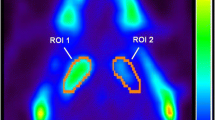Abstract
Aims
To investigate the therapeutic effects of tyrosine hydroxylase (TH)-transfected neuronal stem cells derived from bone marrow stem cells (NdSCs-D-BMSCs) on Parkinson’s disease (PD) through different transplantation protocols, including microinjection into the cerebral ventricles (CV) and the striatum (ST).
Methods
After identification by enzyme digestion, the constructed plasmid pEGFP-C2-TH was transfected into 8-day-cultured NdSCs-D-BMSCs by electroporation resulting in the coexpression of green fluorescent protein (GFP) and TH. The TH-transfected cells were injected into either the right ST or CV of PD rats. The changes in locomotor activity of PD rats and the migration of transplanted cells in cerebral tissue were monitored and cerebral DA levels were assayed by high performance liquid chromatography (HPLC).
Results
Five days after plasmid pEGFP-C2-TH transfection into NdSCs-D-BMSCs GFP was expressed in 62.1% of the cells and the rate of co-expression with TH was 83.5%. Ten weeks following transplantation, the symptoms of PD rats in both groups were significantly improved and DA levels were restored to 46.6% and 33% of control. The transferred cells showed excellent survival rates in PD rat brains and distant migration was observed.
Conclusion
Both CV and ST transplantation of TH-transfected NDSCs-D-BMSCs has obvious therapeutic effects on PD rats. This study could provide evidence for future transplantation route selection, possibly leading to stem cell transplantation through lumbar puncture.






Similar content being viewed by others
References
Berretta N, Freestone PS, Guatteo E, de Castro D, Geracitano R, Bernardi G, Mercuri NB, Lipski J (2005) Acute effects of 6-hydroxydopamine on dopaminergic neurons of the rat substantia nigra pars compacta in vitro. Neurotoxicology 26(5):869–881
Colter DC, Sekiya I, Prockop DJ (2001) Identification of a subpopulation of rapidly self-renewing and multipotential adult stem cells in colonies of human marrow stromal cells, Proc Nat Acad Sci USA 98(14):7841–7845
Debeir T, Ginestet L, Francois C, Laurens S, Martel JC, Chopin P, Marien M, Colpaert F, Raisman-Vozari R (2005) Effect of intrastriatal 6-OHDA lesion on dopaminergic innervation of the rat cortex and globus pallidus. Exp Neurol 193(2):444–454
Jiang X, Xu R, Zhang W (2003) In Vitro experimental study on marking neural stem cells derived from human bone marrow with green fluorescence protein. Chin J Clin Rehab 25(7):3439–3441
Kang UJ, Lee WY, Chang JW (2001) Gene therapy for Parkinson’s disease: determining the genes necessary for optimal dopamine replacement in rat models. Hum Cell 14(1):39–48
Kitada T, Asakawa S, Hattori N, Matsumine H, Yamamura Y, Minoshima S, Yokochi M, Mizuno Y, Shimizu N (1998) Mutations in the parkin gene cause autosomal recessive juvenile parkinsonism. Nature 392(6676):605–608
Lu L, Zhao C, Liu Y, Sun X, Duan C, Ji M, Zhao H, Xu Q, Yang H (2005) Therapeutic benefit of TH-engineered mesenchymal stem cells for Parkinson’s disease. Brain Res Prot 15(1):46–51
Paola RD, Uitti RJ (1997) Treatment implications in the early detection of Parkinson’s disease. Med Pro SEA 24(1):8–11
Paxinos G, Watson C (1998) The rat brain in stereotatic coordinates, 2nd edn. Academic Press, Burlington, MA
Segovia J (2002) Gene therapy for Parkinson’s disease: current status and future potential. Am J Pharmacogenom 2(2):135–146
Shih CC, DiGiusto D, Mamelak A, Lebon T, Forman SJ (2002) Hematopoietic potential of neural stem cells: plasticity versus heterogeneity. Leuk Lymphoma 43(12):2263–2268
Woodbury D, Schwarz EJ, Prockop DJ, Black IB (2000) Adult rat and human bone marrow stromal cells differentiate into neurons. J Neurosci Res 61(4):364–370
Yamada H, Dezawa M, Shimazu S, Baba M, Sawada H, Kuroiwa Y, Yamamoto I, Kanno H (2003) Transfer of the von Hippel-Lindau gene to neuronal progenitor cells in treatment for Parkinson’s disease. Ann Neurol 54(3):352–359
Yuan H, Sarre S, Ebinger G, Michotte Y (2005) Histological, behavioural and neurochemical evaluation of medial forebrain bundle and striatal 6-OHDA lesions as rat models of Parkinson’s disease. J Neurosci Methods 144(1):35–45
Zhang W, Xu R, Cai Y (2002) The activity change of dopamine D2 receptors in caudal-putamen of Parkinson’s disease model rats. Chi J Neurosurgical Dis Res 1(3):266–268
Zou Z, Zhang S, Jiang X (2006) Experimental study on establishment of PD’s rats model by 6-OHDA directional injection. Chi J Neuromed 5(3):244–247
Author information
Authors and Affiliations
Corresponding author
Additional information
Grant: National natural science grant (30270491), Outstanding Science-technology program of Guangdong Province (2000)25.
Rights and permissions
About this article
Cite this article
Zhang, S., Zou, Z., Jiang, X. et al. The Therapeutic Effects of Tyrosine Hydroxylase Gene Transfected Hematopoetic Stem Cells in a Rat Model of Parkinson’s Disease. Cell Mol Neurobiol 28, 529–543 (2008). https://doi.org/10.1007/s10571-007-9191-8
Received:
Accepted:
Published:
Issue Date:
DOI: https://doi.org/10.1007/s10571-007-9191-8




